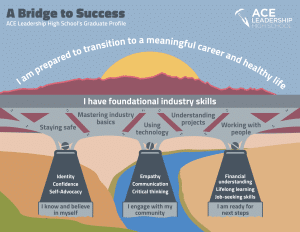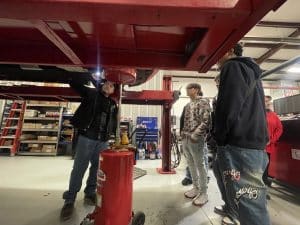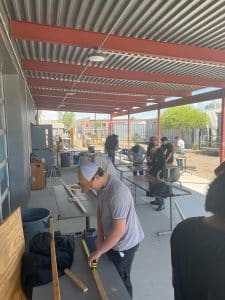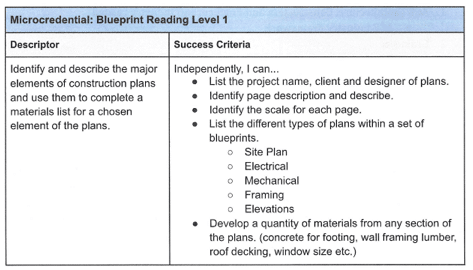Innovation in New Mexico: Bringing Work-Based Learning to Scale at ACE Leadership High School
CompetencyWorks Blog
This post about work-based learning is the fifth in a series about innovation in New Mexico.
Advocates have found that one of the reasons for New Mexico’s high dropout and disengagement rate is that students are being pulled away from school because they choose to join the workforce before graduation. Existing academic options may not feel relevant and/or students face family financial pressures. So a key component of New Mexico’s efforts to rethink students’ educational experiences has been to expand and emphasize work-based learning. Learning through career experience is one key approach to the personalized pathways element of the competency-based education definition: students learn actively using different pathways and varied pacing.
 While ACE Leadership High School in Albuquerque has been centered around teaching core academic content through the architecture, construction, and engineering industries since its founding in 2010, New Mexico’s Innovation Zone legislation and the funding that came along with it enabled the school to expand and refine their offerings. They also combined this with dollars from New Mexico’s Community Schools Fund while embarking on a community journey to define an Industry Framework in June 2021 and a Graduate Profile in January of 2022. These two foundational documents identify how content and academic standards align with the intended real-world outcome and applied industry skills.
While ACE Leadership High School in Albuquerque has been centered around teaching core academic content through the architecture, construction, and engineering industries since its founding in 2010, New Mexico’s Innovation Zone legislation and the funding that came along with it enabled the school to expand and refine their offerings. They also combined this with dollars from New Mexico’s Community Schools Fund while embarking on a community journey to define an Industry Framework in June 2021 and a Graduate Profile in January of 2022. These two foundational documents identify how content and academic standards align with the intended real-world outcome and applied industry skills.
By offering robust opportunities tied to jobs with growth potential and family-sustaining wages, ACE communicates to students that they’ll be on a better path by finishing school than if they leave and work a job that might not have a trajectory for career advancement. Pairing with local employers to provide meaningful work experiences makes school more relevant and encourages students who might otherwise drop out to stay and graduate.
Launching Internships for All ACE Seniors
ACE included a goal to expand work-based learning in their 2021 strategic plan. Several students had participated in the Future Focused Education X3 internship program, which provided a proof-of-concept for including work-based learning as an Innovation Zone element. In 2022, ACE leaders committed to hiring a full-time work-based learning coordinator. Later that same year, when ACE received New Mexico’s Innovation Zone grant, the school was able to offer paid internships for all seniors. Then, in the 2023-24 school year, ACE continued to build out their own system for internships and the range of work-based learning experiences described below.
Internships were integrated as part of the existing senior Capstone course and became a graduation requirement along with Capstone completion. Recent employers hosting internships have included construction firms, a regenerative design firm, and NAPA Auto Parts.

Students find and select their own internships in order to build agency and decision-making and communication skills, but school staff help set them up for success. Julie Jaynes, Work-Based Learning Coordinator at ACE, helps students set up job shadowing to explore different types of jobs and employers and see where they might ultimately want to complete an internship. Jaynes explains: “If a job shadow goes well, [the student] will ask them for an internship. The shadow is a really good way to see the place for the kid and to vet the kid for the workplace — it’s a kind of informal longer interview process. It’s worked well, and community partners and industry partners have really stepped up and been really amazing about hosting young people.”
Students gain a range of skills and self-knowledge through their work-based learning experiences. From becoming more social and comfortable talking to people in public to learning how the trades work to finding full-time work for once they finish school. One student reflected, “This internship program has given me a lot to think about especially when it comes to end goals in terms of careers. I love design and engineering, but I would be lying if I said I enjoyed the office space work environment.” Another realized through their internship that, “working can impact our community and how we treat people can affect their day.”
Expanding School-Wide Through “Work-Based Learning Wednesdays”

In year two of the Innovation Zone funding, ACE expanded work-based learning opportunities to all students in all grades. Wednesdays are now called “Work-Based Learning Wednesdays” for the whole school. In the morning most first- and second-year students complete hands-on workshops with a school staff member and a visiting contractor or industry partner. These can include welding, electricity, carpentry, 3-D printing, math and measurement or power tools, and all options align to multiple Common Core standards.
Juniors are either completing service-learning commitments at a food bank or senior center accompanied by a staff member or attend job shadow experiences in preparation for their senior year. Director of Community Engagement Matthew Salas shares how they scaffold experiences outside of school: “When they’re off site with service learning, interacting with people outside of the school in a public setting, it prepares them for their internship. They’re going to be off campus eventually, so let’s get that little bit of that experience as a junior to prepare them for their senior year.” Seniors work in securing and completing their paid internships during this time.
ACE found that students need multiple avenues to gain work and life skills, since in-class projects alone can’t capture the practice needed to interact with people in a public setting. These internships and job shadow days outside the classroom give students academic credit through real-world experiences. But school-based work also ties in: students can earn microcredentials aligned to each element of the ACE Industry Framework during class projects, including Hand Tool Safety and Use, Blueprint Reading, Photovoltaic Science, and Spreadsheet Software Graphs and Charts. These are discrete industry skills that learners demonstrate through a performance-based assessment. Students can also earn formal industry certifications granted by outside credentialing organizations, like OSHA for occupational safety and CPR/First Aid. For example, one student earned 8 microcredentials and 2 official credentials in 2022 and 2023.
 In the first trimester of 2023, 18% of students were in a paid work-based learning opportunity, which grew to 37% by the end of the school year. ACE refines and adjusts their approach throughout the trimester in response to feedback and student needs, and bigger modifications launch during a new trimester or school year. During the first year of full school Work-Based Learning Wednesdays, for example, they secured two buses in addition to the three vehicles they have to aid transportation. For the 2024 school year, ACE plans to build out the sequence and progression of work-based learning experiences now that they have started earlier with younger students. Key focus areas include balancing hands-on workshops with more basic computer skills such as Microsoft Office or Google Suite and identifying new partners to offer workshops as well as job shadows and internships.
In the first trimester of 2023, 18% of students were in a paid work-based learning opportunity, which grew to 37% by the end of the school year. ACE refines and adjusts their approach throughout the trimester in response to feedback and student needs, and bigger modifications launch during a new trimester or school year. During the first year of full school Work-Based Learning Wednesdays, for example, they secured two buses in addition to the three vehicles they have to aid transportation. For the 2024 school year, ACE plans to build out the sequence and progression of work-based learning experiences now that they have started earlier with younger students. Key focus areas include balancing hands-on workshops with more basic computer skills such as Microsoft Office or Google Suite and identifying new partners to offer workshops as well as job shadows and internships.
Enabling Factors for School-Wide Work-Based Learning
There is significant personalization and customization to support every student in accessing opportunities. Jaynes notes, “Because of the scale of the school, we are able to get to the point where we can make sure that each kid has pretty good access to all these experiences.”
The leadership commitment, community partnerships and willingness to refine and pivot have been enabling factors for the strength and sustainability of ACE’s work-based learning approach. From savvy in blending and braiding funding – such as from Innovation Zone and Community School grants as well as existing state and federal funding sources – to insurance and a process to pay students, it can be helpful to have support, such as from the state or an intermediary organization, to effectively build systems. Additionally, in my conversation with the ACE team, it’s clear they have skills in project management and partnership development as well as being educators who can connect with and support students. The school is a microcosm worth studying as a way to expand work-based learning and innovation across the state.
Final Thoughts on Innovation in New Mexico
Through five posts, I’ve explored how communities in New Mexico are collaborating and innovating to design culturally and linguistically responsive learning environments that advance equity of access and outcomes for New Mexico learners. We explored partnership with communities, graduate profiles, capstone projects, work-based learning, and how the elements of innovation come together in a project-based design at ACE Leadership High School. There are more stories and lessons to learn about the state’s Innovation Zones and I’m excited to follow the momentum building towards key elements of a competency-based education (CBE) system.
Learn More
- The X3 Internship Program Models a Vision for Work-Based Learning
- The Power of Work-Based Learning in Competency-Based Education
- Structuring Schools to Enable Deep, Student-Centered Learning in Real-World Settings
Explore the Innovation in New Mexico Series
- Innovation in New Mexico: The Origins of Community-Driven, Student-Centered Systems Change
- Innovation in New Mexico: Defining Local Visions of Graduate Success
- Innovations in New Mexico: Capstone Projects as a Path to Better Engage Students
- Innovation in New Mexico: Project-Based Learning at ACE Leadership High School
 Laurie Gagnon is the CompetencyWorks Program Director at the Aurora Institute. She leads the work of sharing promising practices shaping the future of K-12 personalized, competency-based education (CBE). Laurie lives in Somerville, MA with her partner, young son, and cat.
Laurie Gagnon is the CompetencyWorks Program Director at the Aurora Institute. She leads the work of sharing promising practices shaping the future of K-12 personalized, competency-based education (CBE). Laurie lives in Somerville, MA with her partner, young son, and cat.